
The Palace of the Governors
2024
MUSEUM OF NEW MEXICO FOUNDATION SPRING
Reimagined
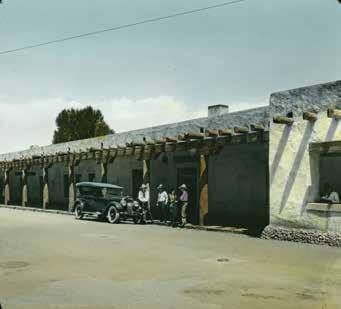
Table of Contents
LETTER TO MEMBERS
BOARD OF TRUSTEES
CELEBRATING THE PALACE
MUSEUM OF INDIAN ARTS AND CULTURE
MUSEUM OF INTERNATIONAL FOLK ART
NEW MEXICO MUSEUM OF ART
NEW MEXICO HISTORY MUSEUM
NEW MEXICO HISTORIC SITES
OFFICE OF ARCHAEOLOGICAL STUDIES
LICENSING
CORPORATE PARTNER SPOTLIGHT LEGACY
OUR MISSION
Opposite: Photo by Saro Calewarts.
The Museum of New Mexico Foundation supports the Museum of New Mexico system, in collaboration with the Museum of New Mexico Board of Regents and the New Mexico Department of Cultural Affairs. The Foundation’s principal activities are fund development for exhibitions and education programs, retail and licensing programs, financial management, advocacy and special initiatives.
We serve the following state cultural institutions:
• Museum of Indian Arts and Culture
• Museum of International Folk Art
• New Mexico History Museum
• New Mexico Museum of Art
• New Mexico Historic Sites
• Office of Archaeological Studies
MEMBER NEWS CONTRIBUTORS
Mariann Lovato, Managing Editor
Carmella Padilla, Writer and Editor
Steve Cantrell, Writer
Jennifer Levin, Writer
Saro Calewarts, Designer
SOCIETY AND WAYS TO GIVE 1 2 3 6 8 10 12 14 16 18 20 21
Cover: A rendering of the recently rehabilitated Palace of the Governors by artist Donna Kandel. Image courtesy New Mexico History Museum.
Above: Palace of the Governors, Santa Fe, New Mexico, ca. 1915. Courtesy of the Palace of the Governors Photo Archives, Neg. No. LS.0453.
museumfoundation museumfoundation
Dear Members,
In this issue, we look at the anticipated Palace of the Governors renovation, a marvel of historic preservation that we can’t wait to share with you. In April, we'll celebrate the unveiling of the reimagined Palace galleries with a festive event that will include tours of the space, as well as food and entertainment that will spill into the Palace courtyard.
The Palace project is just one of the exciting developments at the New Mexico History Museum, which has recently been dedicated to crafting a new strategic vision, called Framework for the Future. To better realize the complexity of its mission, the museum has committed to long-term transformational change that will be exciting for New Mexicans who want to learn more about our communities, cultures and people. For the past six months, museum directors, curators and staff have been working with highly qualified consultants and a statewide committee of cultural experts, disability advocates and educators to jump-start this ambitious process.
In a similar spirit of highlighting community voices, employees at the Museum of International Folk Art lent their perspectives to Staff Picks: Favorites from the Collection. Curators, security guards, educators and others not only chose much-loved pieces to share with visitors—they also wrote the object labels to explain their choices and personal connections to the works. Michelle Rodriguez, a museum cashier, selected Carved Birds, by Ben Ortega, a woodcarver she knew as a child, a reminder of how Santa Fe is at once an international art destination and a small town.
This spring, fashion designer Patricia Michaels will be presented with the 2024 MIAC Living Treasure Award at the Native Treasures Art Market, honoring the Taos Pueblo phenomenon who first caught the world’s eye on "Project Runway" in 2012. At the New Mexico Museum of Art’s Plaza Building, Ways of Seeing: Four Photography Collections features 40 photographs from three recently donated collections, and one promised gift, including works by Manuel Álvarez Bravo, Debbie Fleming Caffery, Alfred Stieglitz and Minor White.
And we welcome Dr. John Taylor-Montoya as the new executive director of the Office of Archaeological Studies. A native of Albuquerque’s North Valley, Taylor-Montoya is a historian and an archaeologist who brings diverse educational, professional and cultural experience to this important leadership position.
As always, thank you for your generous and continued support.
Sincerely,
Jamie Clements President/CEO

In April, we'll celebrate the unveiling of the reimagined Palace galleries with a festive event.
—Jamie Clements
museumfoundation.org | 1

History has been a lifelong passion for Museum of New Mexico Foundation Trustee Dennis “Denny” O’Toole. Two-and-a-half years as a high school history teacher inspired him to earn a Ph.D. in the field, focusing on American, European and Civil War history. He later worked at three history museums, including two outdoor museums, with archaeologists whose historical research aligned with his own interests.
When O’Toole moved to central New Mexico in 1999, it was no surprise he turned his attention to the history-rich cultures and landscapes of New Mexico. Joining the Foundation board in 2013, the New Mexico History Museum became a focal point of his volunteer work and support for museum exhibitions, education and as a member of the Advancement Committee.
In 2023, O’Toole’s experience and dedication led to an invitation from executive director Billy Garrett to participate in the museum’s Framework for the Future initiative focusing on visitor engagement, accessibility and inclusivity.
“I thought the diversity of the group and their experience really contributed a lot of good information to the work," says O'Toole. "I was pleased to accept the invitation.”
Board of Trustees 2023–2024
OFFICERS
Frieda Simons, Chair
Cathy A. Allen,Vice Chair
Michael Knight, Treasurer
Kate Moss, Secretary
VOTING TRUSTEES
Allan Affeldt
David Arment
Nancy Baker
Julia Catron
Joe Colvin
Rosalind Doherty
Diane Domenici
Greg Dove
John Duncan
Gwenn Djupedal
Robert Glick
Carmen Gonzales
Pat Hall
Susie Herman
Ruth Hogan
Peggy Hubbard
Edelma Huntley
Bruce Larsen
John Macukas
Maureen McCarthy
Christine McDermott
Dan Monroe
Patty Newman
Michael Ogg, M.D.
Dennis A. O’Toole, Ph.D.
Sara Otto
Sabrina Pratt
Natalie Rivera
John Rochester
Chris Ryon
Wilson Scanlan
Courtney Finch Taylor
Margo Thoma
Elmer Torres
Robert Vladem
Laura Widmar
David Young
Sandy Zane
Ellen Zieselman
ADVISORY TRUSTEES
Lorin Abbey
Victoria Addison
Keith K. Anderson
Cynthia Bolene
Stockton Colt
Jim Davis
Joan Dayton
George Duncan
Kirk Ellis
Maria Gale
Carlos Garcia
Leroy Garcia
J. Scott Hall
Stephen Hochberg
Rae Hoffacker
Barbara Hoover
Kent F. Jacobs, M.D.
David Matthews
Helene Singer Merrin
Beverly Morris
Mark Naylor
Jane O’Toole
Michael Pettit
Jerry Richardson
Judy Sherman
J. Edd Stepp
Nancy Meem Wirth
Claire Woodcock
HONORARY TRUSTEES
Anne Bingaman
William Butler
Jim Duncan Jr.
John Marion
Carol Warren
Eileen A. Wells
TRUSTEES EMERITI
Saul Cohen
Bud Hamilton
James Snead
MUSEUM OF NEW MEXICO FOUNDATION
Top: Museum of New Mexico Foundation Trustee Dennis “Denny” O’Toole. Photo courtesy Denny O’Toole. Opposite: Sunlight pours through a window at the Palace of the Governors. Photo by Saro Calewarts.
TRUSTEE FEATURE 2 | museumfoundation.org

Celebrating the Palace Past, Present and Future
Sunlight pours through the windows at the Palace of the Governors, New Mexico’s most historic public building. Located across the street from the Santa Fe Plaza, the Palace was built in 1610 as the seat of Spanish colonial government, but changed hands many times over the centuries. Designated as the state’s history museum in 1909, and named a National Historic Landmark in 1960, it is the oldest building in the United States, built by Europeans, still in continuous use.
Today, the 20,000-square-foot adobe structure is part of the New Mexico History Museum campus. In addition to its architectural significance, the Palace is perhaps most famous for the Indigenous artists who sell their work under the exterior portal, which stretches the length of the building along Palace Avenue.
Beginning in 2018, the Palace interior underwent a massive rehabilitation that expanded exhibition space by more than 2,300 square feet, and all galleries are now open to the public. The Palace’s bright white walls and freshly finished floors welcome visitors into the structure’s grandeur, which was hard to perceive in the formerly dim spaces created during a 1970s renovation.
“It was more like a stage set than a museum, with many non-historical elements,” says executive director Billy Garrett, who joined the museum in 2019. An architect with expertise in historic architecture and cultural anthropology, Garrett served as a county commissioner for Doña Ana County from 2011–2018. “The treatment that we’re using is called rehabilitation—historic preservation terminology that means keeping the building in use while maintaining its historic character and features.”
The past, present and future of the Palace will be celebrated at the New Mexico History Museum on Saturday, April 20, in an event highlighting New Mexico’s cuisine, creativity and cultural treasures.
“We are so excited to mark the grand unveiling of the Palace of the Governors after years of extensive renovation,” says Jamie Clements, president and CEO of the Museum of New Mexico Foundation. “Our guests will discover beautifully restored and enhanced interior spaces with new exhibitions that will tell the 400-year-old history of the Palace and its important role in our state’s development and governance.”
Preserving the Palace
As in any well-preserved historic home in Santa Fe, architectural and design features from different eras and residents commingle in the Palace. One room leads to the next and then the next, added over time as space was needed. The rehabilitation revealed covered-over windows and doorways that are now in use, some functionally and some as artifacts. A set of panoramic murals depicting Puye cliff dwellings, originally painted in 1910 by Swedish artist Carl Lotave, were cleaned and restored by Bradford Epley, head of conservation for the New Mexico Department of Cultural Affairs.
Cathy Notarnicola, the museum's curator of Southwest history, finds the rehab especially impressive for the way it opened the sightline through the galleries. “If you’re on one end, you can see all the way through to the other end,” she says. “It seems gigantic compared to the past, when rooms were cut off and windows were darkened to protect hide paintings on the walls.”
Although the Palace received upgraded fire suppression and HVAC systems, curators must be careful about the effect of natural light and dry air on the objects they’re charged with preserving for future generations, Notarnicola explains. The bison-hide works, known as the Segesser Hide Paintings, that once hung on Palace walls are now exhibited in the climatecontrolled Domenici building, behind the Palace on Lincoln Avenue. And the 50 bultos and retablos in The Santos of New Mexico installation in the

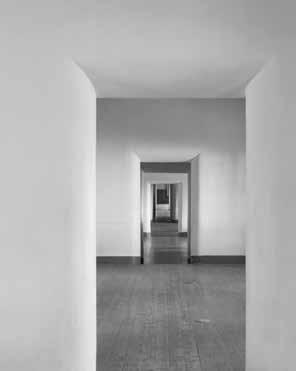
4 | museumfoundation.org
Top spread: Visitors shop for artworks made by Native American artists participating in the famous Palace Portal program. Photo © Daniel Quat Photography.
Bottom: Interior of the Palace of the Governors, showing an end-to-end view of the recently restored building. Photo by Saro Calewarts.
Opposite bottom: Detail of a recently restored panoramic mural depicting the Puye cliff dwellings. The work was created by Swedish artist Carl Lotave inside the Palace of the Governors in 1910. Photo by Saro Calewarts.


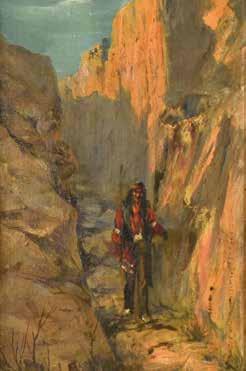
New Beginnings History Homecoming 2024
To purchase tickets to the grand unveiling event on April 20, contact Asya Beardlesy at 505.216.1199 or Asya@museumfoundation.org.
Palace are regularly rotated with others from the Larry and Alyce Frank Collection to protect them from the elements.
Metal items fare better in the Palace climate, such as the unusual sea creatures in Silver and Stones: Collaborations in Southwest Jewelry, featuring pieces made by David Taliman, a Diné silversmith, for Ilfeld’s Department Store in 19th-century Las Vegas, New Mexico. A new exhibition, 18 Miles and That’s As Far As It Got: The Lamy Branch of the Atchison, Topeka and Santa Fe Railroad, features a 32-foot re-creation of the train, meticulously crafted by the Santa Fe Model Railroad Club, that ran between Lamy and the capital city during the 1940s.
The New Mexico Food Heritage Program, a three-year exhibition opening in spring 2024, is sure to inspire similar enthusiasm. Curated by the popular Santa Fe chef Johnny Vee in a renovated gallery space that most recently served as a museum shop, this highly anticipated exhibition celebrates New Mexico ingredients like corn and chile, as well as quintessential dishes, historic restaurants, and top chefs who are carrying on traditions and innovating new ones.
“We’ll have a speaker series, and special dinners and tastings. We’ll extend into the courtyard for tortilla-making demonstrations. We’ll offer take-home recipe cards,” Vee says. “What I wish is that we could figure out a way to have people be able to smell sopaipillas, smell carne adovada.”
Contemplating Complexity
The Palace of the Governors is more than a museum: it is itself a historic object. For many New Mexicans, it’s a place of pride that honors their familial connections to their Spanish and Mexican forebears. For others, it’s a site where their Indigenous ancestors experienced violence and oppression.
The Palace: Seen and Unseen exhibition explores these multiple identities through the building’s archaeological history. The exhibition includes text panels about the different eras, from Spanish colonial occupation through the 1680 Pueblo Revolt, after which various Pueblo peoples transformed the Palace into a high-walled fortress and made it their home. The story continues with the Spanish reoccupation of the Palace in 1693, followed by a period of Mexican rule (1821–1848), settlement as an American territory (1848–1912), and New Mexican statehood in 1912.
Visitors can peer through plexiglass panels at the building’s foundations, uncovered during excavations, and trace different configurations of the room through stain patterns on the floor. The exhibition is on display through 2030 and will be continuously deepened and expanded.
“We can create a space for people to contemplate the age of the building and all of its associations,” Garrett says. “This was the edge of the Spanish empire. This was a colonial capital. There was a high level of stratification within society, and different kinds of relationships with Native peoples, not all of which were positive. This building represents a lot of different things. We want to help people understand the complexity.”
museumfoundation.org | 5
Fashion Forward
Indigenous Designers Weave Tradition, Trend
“Santa Fe is the hub of the Indigenous fashion world,” wrote Vogue magazine in August 2023. And over the years, the Museum of Indian Arts and Culture has played a central role showcasing Native fashion in multiple exhibitions.
This year, two Indigenous fashion icons are being recognized by the museum: the internationally acclaimed Patricia Michaels (Taos Pueblo) and ascendant designer Jontay “Kahm” Kahmakoatayo (Plains Cree).
Michaels is being honored with the prestigious 2024 MIAC Living Treasure Award at this spring’s 20th Annual Native Treasures Art Market. As with other recipients before her, the award recognizes Michaels' outstanding artistic contributions to the field of Indigenous arts and culture. “What an honor to be amongst accomplished artists,” she says. “Taw-aw/Thank you.”
Michaels will also be celebrated with a solo exhibition, Painted by Hand: The Textiles of Patricia Michaels, opening at the museum on May 5.
A turning point early in Michaels’ career was her appearance on "Project Runway" in 2012. Afterward, she says, “People finally accepted my work.” From there, her collection has paraded the runway at New York’s 2013 Mercedes-Benz Fashion Week and graced the 2023 Cannes Film Festival’s red carpet, where she dressed actress Tantoo Cardinal (Cree and Métis) at the Killers of the Flower Moon movie premiere. Conquering fashion's biggest stages, she proved her talent belonged on the world scene.
Michaels’ bespoke couture is greatly influenced by her Taos Pueblo heritage. Describing her fashion style as “very textural, colorful, fluid,” she uses organic, hand-dyed and painted materials as her canvas.

“I grew up in a traditional family in my grandparents’ Pueblo home. He [Michaels’ grandfather] was in charge of our village’s traditions,” Michael says. “I evoke my own history and culture as part of a larger timeless narrative.”
Visionary Native artists like Lloyd Kiva New (Cherokee) paved the way for today's Native artists. In 2016, the museum honored his significant impact on contemporary Native art with the exhibition, A New Century: The Life and Legacy of Cherokee Artist and Educator Lloyd Kiva New. New believed that even the most avant-garde designs were rooted in tradition. And as an artist and educator at IAIA (Institute of American Indian Arts), he urged students to embrace innovation alongside their heritage.
Michaels’ teacher at IAIA, Kimberly “Wendy” Ponca (Osage), also urged her to experiment. Michaels embraced her studies and created a fashionforward ensemble called "Pueblo Chanel." It was included in the museum’s groundbreaking exhibition, Native Couture II: Innovation and Style, in 2009.
To support the Museum of Indian Arts and Culture, contact Lauren Paige at 505.982.2282 or Lauren@museumfoundation.org.
6 | museumfoundation.org
Patricia Michaels (Taos Pueblo) will receive the 2024 MIAC Living Treasure Award at the 20th Annual Native Treasures Art Market. Photo courtesy New Mexico Department of Cultural Affairs.
Influenced by groundbreakers such as Michaels, a new wave of younger Native artists is staying true to their cultural heritage. Some are tapping pop culture imagery to reframe experiences, identities and perspectives— weaving together tradition and trend.
One such artist is Jontay Kahm, the 2023-2024 recipient of the Goodman Aspiring Artist Fellowship. Established in 2016 through the Museum of New Mexico Foundation by longtime museum supporters Malcolm and Connie Goodman, the fellowship provides financial assistance to promising Native artists at an early stage of their career.
A 2023 IAIA graduate in Studio Arts who Vogue declared a "rising star to watch," Kahm saw the award as a springboard to complete his senior thesis collection, titled "Regalian Bodies," of pow-wow regalia reimagined into high-fashion masterpieces. The collection debuted at this past summer’s Indian Market, where the Goodmans bought a miniature red feather/ribbon dress. “The work is impeccable, down to the tiny zipper on the back of the dress,” says Malcolm Goodman.
Kahm's journey began in high school, when he became mesmerized by Lady Gaga's flamboyant music videos and theatrical costumes. “As a kid from the rez, she opened a door to a world I didn’t know existed,” Kahm says.
Teaching himself to sew, he staged his first fashion show in a high school talent show. He is now pursuing his MFA in fashion design on a full scholarship in New York at Parsons School of Design.
“He is a one-of-a-kind artist with a very bright future ahead of him,” Goodman says.


Native Treasures Art Market Memorial Day Weekend: May 24-26
Native Treasures Art Market, presented by the Museum of Indian Arts and Culture, marks its 20th year Memorial Day Weekend with over 150 Native artists, entertainment, children’s activities and more at the Santa Fe Community Convention Center.
Over time, the tireless efforts of countless volunteers have built Native Treasures into an important income source for both the museum and the artists. In partnership with the Museum of New Mexico Foundation, event proceeds benefit the museum’s exhibition, educational programming and acquisitions funds, while participating artists keep 100% of their sales.
The Native Treasures Night Market on Friday, May 24, is your opportunity to shop the market early, enjoy refreshments and live music, and celebrate MIAC Living Treasure awardees: Taos Pueblo fashion designer Patricia Michaels (see page 7) and sculptor Martha Arquero (Cochiti Pueblo), recipient of the 2024 Native Treasures Legacy Award.
Tickets miac.eventbrite.com
Information
museumfoundation.org/native-treasures
Martha Arquero (Cochiti Pueblo), recipient of the 2024 Native Treasures Legacy Award. Photo courtesy New Mexico Department of Cultural Affairs.
museumfoundation.org | 7
Guests peruse the offerings at the Native Treasures Art Market. Photo © Mateo Perez.
Folk Art Favorites
From the Staff
For the first time in the Museum of International Folk Art’s 70-year history, the museum staff took on a collaborative role in curating one of its newest exhibitions. The result—Staff Picks: Favorites from the Collection (on view through August 18)—reveals their personal connections, hidden stories and unexpected interpretations of folk art, illuminating the unique expertise and perspectives of those who know the collection best.
Some 34 staff members across six departments and two museum foundations, the International Folk Art Foundation and Museum of New Mexico Foundation, each chose two works and wrote object labels. Their choices highlight works from 26 countries by 38 known artists and other artists once known, including items from the museum’s Girard Foundation Collection, Neutrogena Collection and International Folk Art Foundation Collection.
Works of tramp art, a woodworking style using discarded cigar boxes and fruit crates, drew the attention of Laura Addison, curator of European and American folk art collections. She chose two early 20th-century tables by Henry Patrick Nugent, writing, “These have little apparent utility…rather, they stand as the artist’s bragging rights as an exceptional craftsman.” Security Guard Collin Bertola found echoes of his Catholic upbringing in New Mexico in the details of a late-19th-to-early-20th century crèche
Others seized on the humor found in many folk art works. Security co-captain Richard "Richie" Lujan chose BoBo bu Ko, artist James Bauer's repurposed lawn chair, which inspired Lujan to imagine, “you had a cold drink and worked on getting your tan.” Guard Fred Salazar found Joe Ortega's carved Alligator With Ice Cream Cone “just fun!," while director of education Leslie Fagre wrote that a Mexican black ceramic deer “made me laugh.”
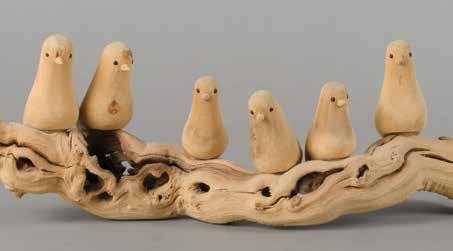
Michelle Rodriguez, museum cashier, selected a small watercolor from 1950. “When I learned [Georgia O’Keeffe] gifted her dear friend Alexander Girard this piece, I knew it had to be shown,” she wrote. She discovered a more personal link in her second selection, Carved Birds by Ben Ortega. The woodcarver was a childhood neighbor who taught her brother the craft.
Nostalgia also took center stage for Cruz Lujan, security co-captain, who imagined himself back on his grandfather's farm when connecting with a circa 1960 John Deere toy tractor. Ecuadorian artist Gabriel Remo Velez’s Kite resonated with bilingual educator Kemely Gomez. “Kite flying season was my favorite time growing up in Guatemala, she recalled. “My brother and I made our kites using plastic bags like the ones used in…Kite.” And preparator Bryan Johnson-French, who spent a portion of his childhood in
To support the Museum of International Folk Art, contact Laua Sullivan at 505 216.0829 or Laura@museumfoundation.org.
Carved Birds, Ben Ortega, Tesuque, New Mexico, late 20th century. Wood and glue. Museum of International Folk Art Collection, gift of the Friends of Folk Art.
Opposite bottom: BoBo bu Ko Robotic Assemblage, James Bauer, ca. 1994. Reused metal and plastic, commercial lawn chair. IFAF Collection. Photo by Kellen Hope.
8 | museumfoundation.org
Bolivia, selected a Bolivian "Dance of the Devils" mask, writing that “the devil dancers in the Easter celebration, Carnaval de Oruro, were my favorite.”
Other selections express serious concerns. Librarian and archivist Brian Graney tapped a subject of national trauma, 9/11 Altarscreen, a powerful collaboration between santero Roberto Gonzales and silversmith Ralph Sena that speaks of shared grief. Educator Patricia Sigala's selection, an Indigenous Brazilian mask made of feathers, wood, resin and mother-of-pearl, inspired environmental considerations. She wrote, "When you look at this mask, I want you to think about the materials being used, the person or people that made it, and what we may all soon lose.”
A sherbet spoon from the mid-19th-century Ottoman era reminded executive secretary and administrative assistant Xochitl Ehrl “to honor the matriarchs in my family whose spoons fed me delicious dishes and healed me with unpleasant tasting remedies.” And educator Dawn Kaufmann wrote that her choice of a ketubah, a Jewish legal marriage contract protecting a bride’s rights in widowhood and divorce, reflects “a folk-art tradition of over 1,600 years still practiced around the world.”
Laurel Seth, executive director of the International Folk Art Foundation, which provided financial support for the exhibition, also weighed in. She recounted the fascinating journey of the Kashmiri-style sitar she chose for display, writing, “In 1967, with a grant from the foundation, Richard Alpert traveled to India where he purchased musical instruments for the [museum] collection. When he returned [it was] as the spiritual teacher Ram Das.”
Staff Picks was also supported by Friends of Folk Art as well as individual donors via the Museum of New Mexico Foundation.


World of Treasures Auction Supports Girard Fund
The Friends of Folk Art, the Museum of International Folk Art’s fundraising juggernaut, presents another not-to-be-missed event—the World of Treasures Auction and Party on Saturday, March 9.
This lively, in-person silent auction will feature more than 70 museum-quality items of folk and fine art, and guests will enjoy delicious hors d’oeuvres, desserts and fine wines. Proceeds benefit the Alexander Girard Legacy Endowment Fund.
Friends of Folk Art member tickets are $50 ($75 for non-members), so it’s a great time to join. Membership also grants early-bird admission to the annual Folk Art Flea. The Flea returns to the Santa Fe County Fairgrounds on Saturday, May 4, with proceeds benefiting the museum’s education programs and exhibitions.
Tickets
Limited and available only at WorldOfTreasures.eventbrite.com
Join Friends of Folk Art 505.982.6366 ext. 100
A carved wood chess set featured in the World of Treasures Auction. Photo courtesy New Mexico Department of Cultural Affairs.
museumfoundation.org | 9
An Eye for Images
Donors Grow Museum’s Photo Collection
It’s often said that art collectors have “a good eye” for pictures, but what does that really mean?
Ways of Seeing: Four Photography Collections, on view through June 16 at the New Mexico Museum of Art’s Plaza Building, attempts an answer. An exhibition of 40 photographs from three recently donated collections, and one promised gift, Ways of Seeing highlights new and never-before-seen images that illustrate a variety of approaches to choosing and assembling a photography collection.
“Ways of Seeing is an interesting study of taste and the profound reasons why collectors select objects for their personal collections,” says Mark A. White, the museum’s executive director. “The exhibition is an important reminder of how collectors have shaped and grown the photography collection of the New Mexico Museum of Art.”
Curator of photography Katherine Ware, who describes collecting as a “fascinating human impulse,” adds, “I love seeing collectors’ interests and passions reflected in what they buy and choose to live with. When each collector approached us, we assessed how their unique vision would complement the museum’s mission and holdings.”
A case in point is photographer and photo dealer Don Moritz, who collected primarily black-and-white prints, including a group by El Rito photographer David Michael Kennedy. After meeting the artist in the early 1990s when taking a class at the Santa Fe Workshops, Moritz becoming one of the artist’s major collectors. In 2022, Moritz donated Kennedy’s portfolio of cloud studies and four additional photographs, all on view amid other museum classics.
Mobil/Trailer, Inyokern, Calif., Jeff Brouws, 1991. Chromogenic print, 18×18 in. Collection of the New Mexico Museum of Art. Gift of Jamie Brunson and Dr. Mark Levy. Photo courtesy Jeff Brouws/Robert Koch Gallery, San Francisco.

“Kennedy’s nuanced prints join in conversation with other cherished cloud photographs in the museum’s collection, including Alfred Stieglitz’s innovative Equivalents, Paul Caponigro’s poignant Rancho San Sebastian and Eliot Porter’s color images of the sky over Tesuque, New Mexico,” says Ware.
Another collector and museum contributor, New Yorker W.M. Hunt, was attracted to “magical, heart-stopping images” of people whose eyes are obscured. Hunt has no clear sense of how his passion for this theme developed, but he says that assembling the photographs “changed my life; it gave me one.” Eight photographs from Hunt’s donation are on view in Ways of Seeing, with works by artists Adam Fuss, Debbie Fleming Caffery, Inge Morath and Saul Steinberg, Ruth Thorne-Thomsen, Arthur Tress, Gerald Slota, Minor White and Joel-Peter Witkin.
To support the New Mexico Museum of Art, contact Alex Wilson at 505.216.0826 or Alex@museumfoundation.org.
10 | museumfoundation.org
Painter Jamie Brunson donated seven photographs from a collection she assembled with her former husband, art historian and teacher Mark Levy, while living in Berkeley, California. They were drawn to large-scale, contemporary photographs from the 1980s through 2000, particularly works that explored the impact of human presence on the landscape. The couple’s shared love of travel and dedication to Kundalini meditation is also reflected in some of their selections. Brunson, who currently lives in Santa Fe, made her donation after Levy’s recent death. Among their donated works on view are images by Jeff Brouws, Kevin Bubriski, John Pfahl and Richard Misrach.
These came to us at a pivotal moment for the museum’s photography collection, which ranges from international to local artists.
Santa Fe collectors Caroline Burnett and her late husband William chose images that moved them deeply, ultimately creating a collection largely of mid-20th-century modernist photographs described by Caroline as works that “represent the beauty, grace and wonder of nature, and offer a sense of peace and serenity.”
It began in 1992 when, as a reminder of their hike to the summit of Cerro Pedernal, Bill gave Caroline a print of Arnold Newman’s photograph of Georgia O’Keeffe at Ghost Ranch. After moving to Santa Fe in 2001, the couple continued collecting, purchasing photographs to celebrate birthdays and holidays.
In the years since Bill’s death, Caroline has continued to refine and develop the collection, which is now designated as a future donation to the museum. A few of the gems on loan for this exhibition are by Ruth Bernhard, Manuel Álvarez Bravo, Alfred Stieglitz, Gertrude Käsebier and Santa Fe photographer Tony O’Brien.
Of these four collections, Ware says, “These came to us at a pivotal moment for the museum’s photography collection, which ranges from international to local artists. We are now looking to add some key pieces to really elevate this strong holding.”
Two gallery talks are scheduled and are free for museum members. On Saturday, March 16, from 11 a.m. to noon, Jamie Brunson, Caroline Burnett and W.M. Hunt share insights about their collections in "My Life as a Collector." On Wednesday, April 10, from 11 a.m. to noon, Anne Kelly, director of Santa Fe’s photo-eye gallery, will talk about beginning your own photography collection.
In-Residence: Angela Ellsworth
The Vladem Contemporary’s inaugural artist-in-residence program, funded by the Frederick Hammersley Fund for the Arts, underscores the crucial role that museums play in fostering artistic development.
Angela Ellsworth, artist-in-residence this spring, brings her unique perspective as a fifth-generation Mormon and queer, feminist artist to create a compelling dialogue with museum visitors in the Dee Ann McIntyre in Memory of Scotty McIntyre Artist Studio. Ellsworth’s Seer Bonnets, on display in the Shadow and Light exhibition, explores this symbol of female modesty and respectability within Mormon culture. The work reflects Ellsworth’s research into acultomancy, the art of divination through needles and pins, a practice she will share with visitors. Ellsworth also invites visitor participation through her reinterpretation of Mormon line dancing, orchestrating a silent form of the tradition on the museum’s rooftop terrace.
Alexandra Terry, the museum’s curator of contemporary art, says this stripped-down experience “speaks to Ellsworth’s interest in art merging with everyday life.”
 Seer Bonnets by Angela Ellsworth. Photo © Chloe Accardi.
Seer Bonnets by Angela Ellsworth. Photo © Chloe Accardi.
museumfoundation.org | 11
Framing the Future
Addressing New Mexico’s Myths and Truths
New Mexicans take pride in their rich, diverse history, celebrating connections to land, food and family while wrestling with such darker legacies as colonization and atomic power.
State history is also a source of interest for visitors, many of whom come to the New Mexico History Museum to learn and engage. Located just off the Santa Fe Plaza, the museum campus contains the historic Palace of the Governors, a museum building on Lincoln Avenue, a research library and photography archive.
But telling New Mexico history is a difficult task. Too often the museum has reinforced the tourist-friendly myth of a tricultural Santa Fe—with Native peoples, Hispanos and Anglos living “in harmony” in the country’s oldest capital city. This myth not only dismisses the longtime contributions of other cultures in the city’s history, it glosses over the complex relationships among the cultures who call the region home.
As museums everywhere shift to more inclusive storytelling models, New Mexicans are clamoring for more from their history museum. They want a more vibrant museum experience, with exhibitions that engage the senses. They want stories from around the state that explode myths, explore lesser-known communities and cover different time periods. And they want to help tell those stories.
“The museum recognized that there were gaps in what it was doing, and they needed a better understanding of how the museum was operating and could better serve New Mexicans,” says John Chiodo, an internationally known exhibition designer who helps museums develop contemporary storytelling models. “To do that, we had to open up the doors and pull in input about what the museum should be doing.”
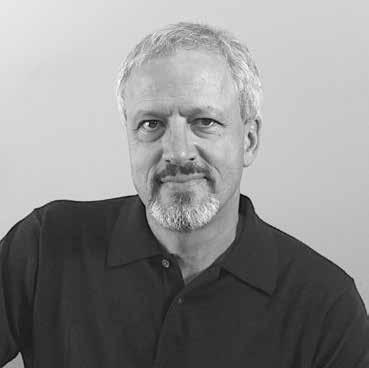
Chiodo worked at the museum with Gail Anderson, a consultant in organizational transformation, to develop what they’re calling a Framework for the Future. Though both have worked with national and international museums and educational institutions, Anderson and Chiodo live in Santa Fe and bring their vast expertise to this crucial project in their hometown.
“Telling the many truths that make up our state, in the voices of our state, is so powerful,” Anderson says. “I think it will engender greater interest in our history, instead of promoting old ideas.”
Throughout 2023, the consultants met weekly with a staff steering committee, led by museum executive director Billy Garrett and deputy director Catherine Trujillo. Beginning in June, they held four virtual workshops with a statewide planning committee, culminating in a fifth and final in-person session in December. The committee was comprised of experts in
To support the New Mexico History Museum, contact Jamie Clements at jamie@museumfoundation.org.
Exhibition designer John Chiodo helped develop the New Mexico History Museum’s Framework for the Future. Photo courtesy John Chiodo.
12 | museumfoundation.org
their fields, including Porter Swentzell, head of education at Santa Clara Pueblo; Nikki Nojima Louis from the New Mexico Japanese American Citizen League; and Chris Wilson, University of New Mexico professor emeritus and author of The Myth of Santa Fe: Creating a Modern Regional Tradition. As part of this process, the museum also issued a public survey completed by more than 700 people statewide.
Improving accessibility is a key part of Framework for the Future. Museums often rely on purely visual mediums like photography and wall text, which isn’t especially fulfilling for people with visual impairments or those who simply learn better when information is delivered differently, says planning committee member Greg Trapp, executive director of the New Mexico Commission for the Blind. “You can have an app or a button that you push, and you can listen to a description of that panel. Museums that I especially enjoy offer a greater tactile experience. Certainly not all exhibits permit that, but there are ways to have narrative that make the experience more interesting.”
Although bandwidth issues in rural areas of New Mexico limit how people experience the internet, online exhibitions and programs are also vital to accessibility initiatives. Traveling exhibitions are another way to bring the museum to the people, especially school groups that can’t take field trips to Santa Fe.
The goal of the Framework process was the development of a living document that can be refined over time. Change doesn’t happen overnight, the consultants say, and the goal is not to slap a shiny bandage on a systemic problem.
“The workshops were like a series of stepping stones. In between, we reported to the steering committee to discuss our findings and formulate how we wanted to present subsequent workshops,” Chiodo explains.
The result is not a list of exhibitions or a diversity checklist, but a strategy for the museum to use when planning exhibitions and public programming, and when building relationships with communities and other institutions around the state.
“In this process, you’re moving an embedded, centuriesdeep style of museums to the 21st century. You’re thinking completely differently about your role as a museum, about your community and the public’s involvement,” Anderson says. “Quick solutions get stuck on the shelf when they don’t work. Framework for the Future allows the New Mexico History Museum to try new things, learn from their mistakes, and then try again.”
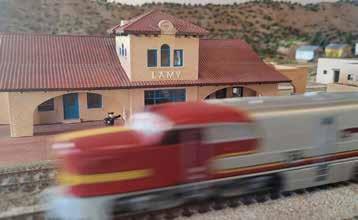
All Aboard at the Palace!
The New Mexico History Museum’s delightful exhibition, 18 Miles and That’s As Far As It Got: The Lamy Branch of the Atchison, Topeka and Santa Fe Railroad, explores the unique connection between the little town of Lamy and the legendary capital city of Santa Fe. On view in the Palace of the Governors, the exhibition highlights a 32-foot model of a Lamy train, meticulously crafted by the Santa Fe Model Railroad Club. This railway masterpiece transports viewers back to the early 1940s, when wood-framed buildings, traditional adobe houses, stockyards and the once-thriving "Harvey House" defined the community.
These architectural gems—anchored at one end of the tracks by Lamy’s iconic El Ortiz Hotel and at the other by La Fonda and the Palace of the Governors—showcase "Santa Fe Style," a blend of Pueblo, Spanish and Mission influences that remain a defining characteristic of the region's unique identity. Maps, vintage photographs and text panels flesh out the fascinating story of the railroad’s important role in community development.
Lamy model train. Photo courtesy New Mexico History Museum.
museumfoundation.org | 13
Tribal Collaborations
Connecting Place and the Public
New on the job, Katrina Gallegos, site manager of Jemez and Coronado historic sites, is looking forward to putting into practice her passion for preserving and protecting the land.
Gallegos hails from the Cinco Puntos/Atrisco neighborhood in Albuquerque’s South Valley, where she served as a water commissioner helping farmers and ranchers in the South Valley Regional Acequia Association. She “still walks the ditch banks of the acequias with my mother and nephew,” she says, “admiring the beauty of the countryside and the noisy Sandhill Cranes that make life unique and worth preserving.”
Last May, after receiving her master’s degree in museum studies from Baylor University in Waco, Texas, Gallegos says she started searching for jobs where she could “preserve and promote history and culture. When I saw the position at Coronado and Jemez, I knew it aligned with my goal of promoting New Mexican history.”
Gallegos is currently overseeing a project funded by the state legislature to rewrite and install interpretive signage throughout the Pueblo ruins at Jemez, which is also a National Historic Landmark. And since a story (and in this case, the signage) requires a knowledgeable storyteller, Gallegos is collaborating with Jemez Pueblo members in developing the narrative. Other Jemez site staff, who are themselves members of the Pueblo, are also participating.
Gallegos would like to build upon this partnership with the Pueblo as a model to create new programs. Two previously successful programs from 2012 and 2014 are serving as inspiration for the new ones.
The 2012 program, Stories from the Land, brought children from the Jemez Pueblo Community Library to the historic site for a weeklong summer reading and writing program. While there, Pueblo students and teachers shared stories of their culture and upbringing with one another. The project was conceived as a way to pass Native traditions to younger generations of tribal members.
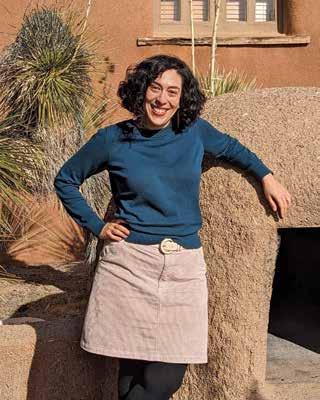
In 2014, the Elders in Residence program engaged Jemez elders to provide tours and share personal stories about the site with the general public. Made possible by a grant from the New Mexico Historic Preservation Division, the six-week summertime initiative featured a different elder each week, powerfully connecting visitors with more than an abandoned ruin, but with a thriving tribal community.
Both programs were a huge hit, increasing visitor attendance over 30%. But when the funding for Elders in Residence ended, so did the program. Now, Gallegos is seeking funding to bring a similar program back to Jemez. She has ideas to expand it to Coronado Historic Site as well.
To support the New Mexico Historic Sites, contact Asya G. Beardsley at 505.216.1199 or Asya@museumfoundation.org.
Katrina Gallegos, Jemez and Coronado historic sites manager. Photo by Marlon Magdalena.
14 | museumfoundation.org
New Mexico Historic Sites Deputy Director Matt Barbour, the previous Jemez site manager who implemented the programs, describes their importance in engaging and educating visitors: “Not every visitor to the site is able to get a personal tour with a ranger. Most have a [printed] trail guide. A good trail guide, mind you—but not a person. As a result, things get misinterpreted, and sometimes people become disengaged…the trail guide lacks the human element.”
For Gallegos, gaining private support for tribe-inspired public education programs is vital to the public’s understanding of the significance, in history and today, of Jemez.
“It is through stories that we connect with a place,” she says. “These hoped-for programs, in collaboration with the Pueblo’s artists and cultural leaders, will continue to spark new and vibrant conversations with visitors to Jemez Historic Site.”
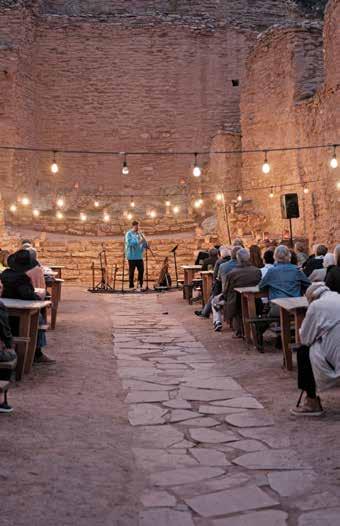

Preserving Fort Stanton
In 2023, in a significant move to care for one of the most intact 19th-century military forts in the country, and the best-preserved fort in New Mexico, an interdisciplinary team of historians, architects and landscape architects issued the Fort Stanton Historic Site Cultural Landscape Report.
Located just outside of Lincoln, the 240-acre Fort Stanton is best known for its roles in the Indian Wars and the Civil War. The new report is valuable for understanding site conditions, preventing buildings from falling into disrepair and ensuring that future funding is allocated effectively.
The largely unoccupied and underutilized state of the site was deemed its greatest threat. Addressing this concern, the state legislature allocated $367,656 in 2023 and an additional $3.5 million was received through the federal American Rescue Plan Act.
“With the government funds, we have begun to address infrastructure needs,” says Oliver Horn, regional manager for New Mexico Historic Sites. “We still need private support for more public facing efforts, like educational programming, interpretive site signage and much more.”
Above: Members enjoy an evening concert at Jemez Historic Site. Photo © Gabriella Marks.
Top right: Fort Stanton Historic Site. Photo courtesy New Mexico Historic Sites.
museumfoundation.org | 15
Our Collective Past
New Director Emphasizes Lived Experiences
Growing up in his native Albuquerque, John Taylor-Montoya enlisted the willing support of his two sisters to conduct, in his words, “archaeological digs” in the backyard of the family’s North Valley home. His childhood fascination with the prospect of unearthing the unknown would eventually lead him to a distinguished career in public archaeology, including his recent appointment as executive director of the Office of Archaeological Studies.
In addition to digging holes in his backyard, he describes as "deep enough to do double-duty as childhood forts,” Taylor-Montoya had a passion for drawing. One day, while browsing the shelves in the La Luz Elementary School library, a book cover with King Tut's iconic gold mask caught his gaze. Even more enticing was the book’s title—Art and Archaeology perfectly pairing his love for artistic expression with his curiosity about the past.
Taylor-Montoya's parents actively nurtured his budding interests, gifting him books on history and archaeology for birthdays and holidays. This complemented family vacations to such favorite New Mexico sites as the ruins at Salinas Pueblo Missions National Monument, Coronado Historic Site's Kuaua Pueblo, and Jemez Historic Site's Gíusewa Pueblo and San José de los Jémez mission. These formative experiences further ignited his passion for the field, setting him on a path to undergraduate and graduate degrees in anthropology.
Taylor-Montoya spent 20 years working in the private sector “throughout the greater Southwest, at sites that run the full range of resources, from Ice Age Paleoindian sites to Puebloan sites, to Cold War-era military facilities and historic buildings.” There, he developed the diverse background needed to lead the OAS, a complex organization with varied programs and stakeholders—including groups of enthusiastic individuals who volunteer at the Center for New Mexico Archaeology and participate in such educational programs as the Friends of Archaeology.

Taylor-Montoya, who worked briefly as an OAS program director before taking the helm, was attracted to this new position because of the division’s strong educational focus, which he says will allow him to be “more directly involved in people’s lives in New Mexico, to be more among the gente.”
Wearing the dual hats of historian and archaeologist, Taylor-Montoya asserts that 21st-century archaeology in New Mexico should enhance our understanding of the state’s diverse historical legacies. “Our stories—those
To support the Office of Archaeological Studies, contact Lauren Paige at 505.982.2282 or Lauren@museumfoundation.org.
Dr. John Taylor-Montoya, executive director of the Office of Archeological Studies. Photo by Saro Calewarts.
Opposite bottom: Shelby Jones, Office of Archaeological Studies lab supervisor, shows one of the 15,000 archaeomagnetic specimens in the Dr. Robert DuBois Estate collection.
Photo by Saro Calewarts.
16 | museumfoundation.org
of the Native Americans, Hispanos, and those who’ve more lately come to this state—they don't just reside in history books, they resonate through the lived experiences of our families today, enriching our understanding of our collective past," he says.
Drawing from his own graduate experience, where comparative collections at other institutions enriched his university studies, Taylor-Montoya envisions utilizing OAS’s unique collections and data to similarly enhance the education of today’s university students. He also sees OAS leveraging its resources with other divisions within the New Mexico Department of Cultural Affairs, such as New Mexico Historic Sites. By actively pursuing these collaborations, he says, OAS can sustain and grow its already well-deserved reputation as a vibrant hub for learning, research and community engagement.
The results of OAS’s vital scientific inquiries should “flow seamlessly from our laboratories to OAS's awardwinning outreach programs, engaging our publics—from curious elementary schoolers to enthusiastic laypeople,” he says. To that end, Taylor-Montoya seeks to further broaden OAS audiences through social media, as well as through educational and interpretive materials distributed at outreach events.
As an institution with a statewide mandate, TaylorMontoya understands that OAS programs require private funding through the Museum of New Mexico Foundation for program preparation and delivery, supplies and travel. He says that more active statewide marketing of OAS, in addition to the greater visibility that social media provides, will “raise public awareness and promote understanding and support for archaeology's ability to contribute to our communities.” This, in turn, will “facilitate support from potential new [donor] prospects.”
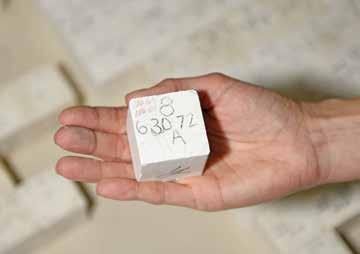
Funding Scientific Discovery
Data management of collections, both active and legacy projects, is a critical component of scientific discovery and progress. Yet, in most cases, there are few funding opportunities available solely for data management projects.
Although this seems to be changing at a national and international level, there is a consistent need for privately-sponsored support of ongoing data management at the laboratories at the Office of Archaeological Studies. Current opportunities to fund such projects include:
• The organization of the Dr. Robert DuBois Estate collection of roughly 15,000 archaeomagnetic specimens, data and field notes.
• The inclusion of the Eighmy/Lengyel/ Sternberg collection of 20,000 archaeomagnetic specimens, data and archaeological notes into the OAS laboratory archives.
• The development of a digital database in the Radiocarbon Sampling Laboratory aligned with the data standards of the National Science Foundation.
“The gold standard in scientific databases is to adhere to the acronym FAIR—data that are Findable, Accessible, Interoperable and Reusable,” says Shelby Jones, OAS laboratory supervisor. “Our labs have been working to achieve this goal for our tens of thousands of laboratory samples for years, and 100% of those efforts have been supported through the Museum of New Mexico Foundation and other donated funds. As we acquire additional specimens, the need for additional support continues. Once completed, the materials in these laboratories will serve as a sample research library for scientists across the U.S. and world.”
museumfoundation.org | 17
The "New Old Santa Fe"
Inspiration for the Museum of New Mexico Collection
Ernest Thompson of Albuquerque and the Museum of New Mexico Foundation licensing department proudly announce the introduction of The Museum of New Mexico Collection, a furniture collection inspired by pieces in the New Mexico Museum of Art.
When the museum was built in 1917 as the Art Gallery of the Museum of New Mexico, its focus was the art of all New Mexicans. In 1962, the name was changed to the Museum of Fine Arts, and in 2007, it became the New Mexico Museum of Art “to reflect the breadth of New Mexico art.”
Anchoring the northwestern corner of the Santa Fe Plaza, the 1917 building today is an icon of Santa Fe Style. Its story is the inspiration for the collaboration that led to The Museum of New Mexico Collection.
The History
Since its founding in 1610 as the capital city of the Spanish empire in New Mexico, Santa Fe has been at the crossroads of history, culture and commerce. Over 200 years of trade from Europe, Mexico and Kansas City delivered goods and design styles to the region, which was already home to a large population of Native Americans before Spanish colonization. In the 20th century, transplants from the East Coast joined the burgeoning community. Over time, the region’s diverse residents blended and reinterpreted the design motifs and craft traditions indigenous to and from outside the region. The result? A unique stylistic expression melding Spanish, Native American and American traditions.
The 1880 arrival of the railroad almost upset this stylistic apple cart. Not only did it transport new visitors and residents, it delivered manufactured goods, building supplies and elements of the Victorian style in vogue at the time. Newcomers and locals alike were keen to fill their homes with these goods and adopt the style of the day. With access to ready-made building materials, there was a rush to build a new style of home—one made of bricks, featuring Victorian detailing instead of the traditional Spanish–style adobe. In the process, many of Santa Fe’s original homes were razed.
In 1912, New Mexico became the 47th state in the U.S. and, with that, came more economic and political pressure to conform to national norms. Sensing a threat to the town’s unique character, a group of prominent historians, anthropologists and architects gathered to discuss re-envisioning the identity of the capital city to ensure its economic viability.
In what would today be called a re-branding exercise, the group devised a program for developing a signature architectural style blending Spanish and Native American traditions with emerging 20th-century styles. This style and its subtle iterations came to be alternately known as Pueblo Revival and the New Old Santa Fe Style.

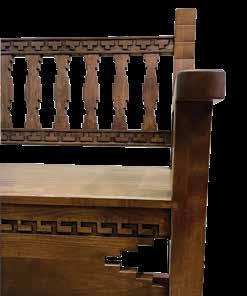 Top and detail: The Hudelson Bench, inspired by a bench in the New Mexico Museum of Art made by Samuel F. Hudelson. Photo by Susan Chiasson, courtesy Ernest Thompson.
Top and detail: The Hudelson Bench, inspired by a bench in the New Mexico Museum of Art made by Samuel F. Hudelson. Photo by Susan Chiasson, courtesy Ernest Thompson.
LICENSING 18 | museumfoundation.org
The Makers
Jesse Nusbaum, a teacher and noted anthropologist, played an integral role in the formulation and execution of the New Old Santa Fe Style. In 1911, Nusbaum was picked by Museum of New Mexico founder Edgar L. Hewett to oversee the restoration of the Palace of the Governors, the seat of government for the Spanish from 1610 until 1821, which was to be the home for the Museum of New Mexico established in 1909. Hewett turned to Nusbaum again to help flesh out the architectural detailing of the Art Gallery of the Museum of New Mexico.

To learn about Spanish colonial furniture and architectural traditions of the 18th and 19th centuries, Nusbaum traveled extensively throughout northern New Mexico visiting villages, churches and homes. At a home in Velarde, he saw a small chest featuring the chip-carved bullet motif that he chose as a signature design for the architectural detailing of the new museum and in much of the furniture designed for the Women’s Board Room. Strategically located within the museum galleries, the board room provided space for meetings, for entertaining vistors and dignitaries and to showcase the New Old Santa Fe Style.
Nusbaum’s colleague, Samuel F. Hudelson, taught industrial arts for the Indian Service on several reservations before coming to Santa Fe in 1912 to work on the renovation of the Palace of the Governors. In 1921, Hudelson joined the Art Gallery of the Museum of New Mexico as building superintendent. Hudelson was also a gifted furniture maker and built many pieces for the museum and Women’s Board Room, which incorporated Native American pottery and weaving designs.
Nusbaum and Hudelson’s efforts to integrate these culturally inspired motifs into the architecture and interiors of the 1917 Art Gallery lit the spark that would fan the flames of the 20th-century design movement known as the New Old Santa Fe Style.
The Collection
The Museum of New Mexico Collection, artisan-made and marketed by Ernest Thompson, celebrates Nusbaum and Hudelson’s influence by reinterpreting some of the key pieces they designed and made. Comprised of 11 pieces, the collection includes three distinct groups: a dining room set (dining table, console, cocktail table and sideboard) referencing the iconic chip-carved bullet motif; a bedroom group (bed, bench, dresser and nightstand) representative of Hudelson’s appreciation for Native American designs; and three stand-alone pieces.
“We take great pride in our role providing furniture and cabinetry for those who appreciate the tradition of New Mexico furniture-making,” says Mike Godwin, owner and lead designer of Ernest Thompson for 34 years. “Our partnership with the Museum of New Mexico Foundation exemplifies our commitment to the Native American, New Mexican and Spanish design traditions in all that we build. It is an honor to engage our New Mexicobased artisans in the creation of these fine collection pieces.”

Member Event
Pamela Kelly and Mike Godwin discuss
The Museum of New Mexico Collection
Thursday, March 14
New Mexico Museum of Art
Details: museumfoundation.org/events
Top and detail: The Velarde Console Table, inspired by carvings Jesse Nusbaum saw in Velarde, New Mexico.
Photo by Susan Chiasson, courtesy Ernest Thompson.
museumfoundation.org | 19
Avalon Trust
Cultivating Cultural Responsibility
Venerable institutions survive because people nurture them, generation after generation.
“It’s easy to take for granted that a museum has been around for 100 years—but it’s here a century later because many generous people have made funding it a priority,” says Andrew Wallerstein, chief executive officer and partner at Avalon Trust, a Santa Fe-based investment and financial planning company founded a quarter-century ago.
As a Museum of New Mexico Foundation corporate partner for more than a decade, Avalon is one of the generous entities that prioritize funding for the Museum of New Mexico system. Though they have additional offices in the New York area and Pacific Northwest, most employees live and work in Santa Fe, and the company emphasizes giving back to the community.
Avalon’s leadership team, Wallerstein and partners Christine McDermott and Julia Peters, are serious about philanthropy, directing a portion of their personal giving to the museums via the Foundation, supporting exhibitions, capital campaigns and annual funds. McDermott, who grew up in Santa Fe, is a Foundation trustee and serves on the investment committee.
Avalon also encourages its employees to consider the Foundation for charitable giving, and as a benefit of its Foundation partnership, employees receive free museum admission. The company has hosted company events in the New Mexico Museum of Art courtyard— another benefit of partnership.
“So many arts and culture organizations are struggling right now, not just here, but in New York, Chicago and Los Angeles. I would hate to see the arts diminish in any way, because they provide so much for so many. We try to make sure that won’t happen,” Wallerstein says.

Avalon offers independent investment management and fiduciary advice and manages nearly $2 billion. The company spreads its philanthropy to many areas of Santa Fe, collaborating with clients to extend its community support. The company keeps a list of about 30 groups and institutions it gives to throughout the year, and sends the list to clients to inspire further giving.
“We’re able to give generously because of our clients’ loyalty to us. We also encourage them to give additional support to these groups,” says Wallerstein. “Our clients are with us for decades, with multigenerational groups. We take that responsibility very seriously.”
To learn more about becoming a Corporate Partner, contact Mariann Lovato at Mariann@museumfoundation.org or 505.216.0849.
CORPORATE PARTNER SPOTLIGHT
20 | museumfoundation.org
Julia Peters, Andrew Wallerstein and Christine McDermott. Photo © Peter Ogilvie.

Charitable Gift Annuity Do Good, Receive Payments for Life
When Bruce Larsen learned of a new law, the Secure 2.0 Act of 2022, which allowed donors 70½ years or older to make charitable donations from their IRA accounts and receive payments for life in return, he embraced the opportunity.
“When I learned that a qualified charitable distribution from my IRA could be used to fund a charitable gift annuity, I immediately thought of the Museum of New Mexico Foundation," says Larsen, a longtime Foundation trustee. “I knew that my donation would be in good hands, and in this case, would ultimately benefit our [Bruce and wife Mary Anne’s] favorite museum, the Museum of International Folk Art. A lower tax bill in 2023 and ongoing income is a win-win.”
This special type of charitable gift annuity can be created only once in a donor’s lifetime and is limited to $50,000. Funds remaining after your lifetime of payments will continue to support the Foundation’s mission in your name.
To learn how to
Ways to Give
MEMBERSHIP
Support the Museum of New Mexico Foundation in delivering essential services to our 13 partner cultural institutions while offering enjoyable member benefits.
THE CIRCLES
Participate in a series of exclusive events while providing leadership-level support.
CIRCLES EXPLORERS
Support and explore the art, culture and history of New Mexico through active, adventurous, and educational cultural excursions and experiences.
CORPORATE PARTNERS AND BUSINESS COUNCIL
Support the museums through your business and receive recognition and member benefits for your business, clients and employees.
ANNUAL FUND
Provide critical operating support for the Museum of New Mexico Foundation to fulfill its mission on behalf of our 13 partner cultural institutions.
EXHIBITION DEVELOPMENT FUNDS
Support exhibitions, related programming and institutional advancement at the division of your choice.
EDUCATION DEVELOPMENT FUNDS
Fund museum education and public outreach programs at our four museums, eight historic sites and the Office of Archaeological Studies.
PLANNED GIVING
Provide a long-lasting impact at our 13 partner cultural institutions through a bequest, beneficiary designation, charitable gift annuity, charitable remainder trust or gift of art.
ENDOWMENT FUNDS
Establish a new fund, or add to the principal of an existing fund, to provide a reliable source of annual income that sustains a variety of cultural programs and purposes.
SPECIAL CAMPAIGNS
Give to special campaign initiatives designed to fund a range of capital expansions and programming advances throughout the Museum of New Mexico system.
For more information, visit museumfoundation.org/give.
LEGACY SOCIETY
Top: Mary Anne and Bruce Larsen. Photo © Gabriella Marks.
create a charitable gift annuity by using a qualified charitable distribution from your IRA, contact Laura Sullivan at 505.216.0829 or Laura@museumfoundation.org.
Artistic Adornments
Jewelry by Bernadette Marquez and Art Lopez at the Spiegelberg Shop in the New Mexico History Museum

Railyard Arts District
George Duncan and Sheryl Kelsey Shop
Vladem Contemporary
Santa Fe Plaza
Spiegelberg Shop
New Mexico History Museum
Rosalie D. and Steven J. Harris Shop
New Mexico Museum of Art
Museum Hill
Lynn Godfrey Brown Shop
Museum of International Folk Art
Colleen Cloney Duncan Shop
Museum of Indian Arts and Culture
shopmuseum.org


















 Seer Bonnets by Angela Ellsworth. Photo © Chloe Accardi.
Seer Bonnets by Angela Ellsworth. Photo © Chloe Accardi.








 Top and detail: The Hudelson Bench, inspired by a bench in the New Mexico Museum of Art made by Samuel F. Hudelson. Photo by Susan Chiasson, courtesy Ernest Thompson.
Top and detail: The Hudelson Bench, inspired by a bench in the New Mexico Museum of Art made by Samuel F. Hudelson. Photo by Susan Chiasson, courtesy Ernest Thompson.




